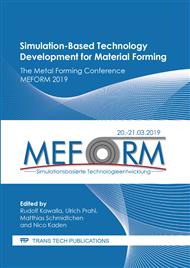[1]
Behrens, B.-A. et al., Role of Thermal Processing in Tailored Forming Technology for Manufacturing Multi-Material Components,, Heat Treat 2017: Proceedings of the 29th ASM Heat Treating Society Conference, October 24-26, Columbus, Ohio, USA.
Google Scholar
[2]
Wagener, H.W. and Haats, J., Pressure welding of corrosion resistant metals by cold extrusion,, Journal of Materials Processing Technology, 45–1, (1994), pp.275-280.
DOI: 10.1016/0924-0136(94)90352-2
Google Scholar
[3]
Rhee, K.Y. et al., Fabrication of aluminum/copper clad composite using hot hydrostatic extrusion process and its material characteristics,, Materials Science and Engineering: A, 384–1–2, (2004), p.70–76.
DOI: 10.1016/j.msea.2004.05.051
Google Scholar
[4]
Schlemmer, K.L. and Osman, F.H., Differential heating forming of solid and bi-metallic hollow parts,, Journal of Materials Processing Technology, 162–163, (2005), pp.564-569.
DOI: 10.1016/j.jmatprotec.2005.02.124
Google Scholar
[5]
Behrens, B.–A. et al., Investigation of load adapted gears and shafts manufactured by compound–forging,, Journal of Advanced Manufacturing Systems, 7–1, (2008), p.175–182.
DOI: 10.1142/s0219686708001292
Google Scholar
[6]
ThyssenKrupp Tailored Blanks GmbH, Tailored Blanks Optimierte Bauteile aus Stahlblech,, Product Catalogue, Issue 10, (2004).
Google Scholar
[7]
Wang, J. et al., Study of the hot forging of weld cladded work pieces using upsetting tests,, Journal of Materials Processing Technology, 214–2, (2014), p.365–379.
DOI: 10.1016/j.jmatprotec.2013.09.009
Google Scholar
[8]
Domblesky, J. et al., Welded preforms for forging,, Journal of Materials Processing Technology, 171–1, (2006), p.141–149.
DOI: 10.1016/j.jmatprotec.2005.06.066
Google Scholar
[9]
Frischkorn, C. et al., Investigation on a new process chain of deposition or friction welding and subsequent hot forging,, Materialwissenschaft und Werkstofftechnik, 44, (2013), p.783–789.
DOI: 10.1002/mawe.201300133
Google Scholar
[10]
Behrens, B.-A. et al., Basic study on the process combination of deposition welding and subsequent hot bulk forming,, Production Engineering, 7–6, (2013),p.585–591.
DOI: 10.1007/s11740-013-0478-y
Google Scholar
[11]
Xiong, J. et al., Cellular automata simulation of dynamic recrystallization in rotary friction welding of pure copper,, Indian Journal of Engineering & Materials Sciences, Vol. 24, (2017), pp.377-382.
Google Scholar
[12]
Behrens, B.-A. et al., Co-Extrusion of Semi-Finished Aluminium-Steel Compounds,, Proceedings of the 20th International ESAFORM Conference on Material Forming, (2017), AIP Conf. Proc. 1896, 140002-1–140002-6.
Google Scholar
[13]
Behrens, B.-A. et al., Importance of Material and Friction Characterisation for FE-aided Process Design of Hybrid Bevel Gears,, Proceedings of the 20th International ESAFORM Conference on Material Forming, (2017), AIP Conf. Proc. 1896, 190016-1–190016-7.
DOI: 10.1063/1.5008229
Google Scholar
[14]
Guo, Z. et al., Modelling of materials properties and behaviour critical to casting simulation,, Materials Science and Engineering A, 413-414, (2005), pp.465-469.
DOI: 10.1016/j.msea.2005.09.036
Google Scholar


